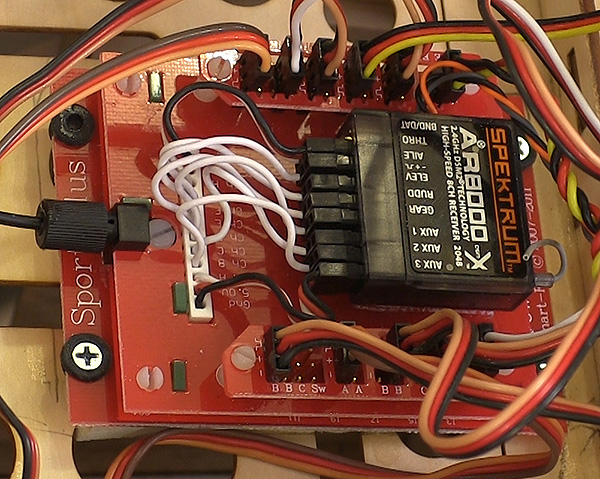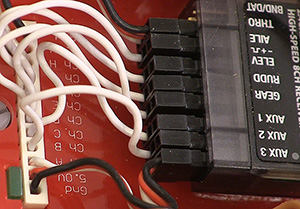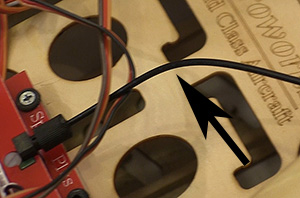



One of the first true redundant battery systems, the SmartFly was and is very
popular.
Text and photos by Tom Hintz
Posted - 11-4-2014
There are few things in RC flying worse than seeing a large, expensive model go into the dirt because of a power delivery problem within its systems. When the models get larger they need high torque servos which increase power consumption, often at a higher voltage than the receiver can safely use without regulation. Dual batteries helps but we still need a sophisticated power delivery system to insure true redundancy as well as clean, filtered current being sent to the receiver. If we consider the cost of fielding moderate to large planes the price of adding effective, redundant protection looks very small.
When I was building my Aeroworks 50cc Pitts Python ARF-QB I noticed Smart-Fly systems in some of the other planes at our field. Though they have a full range of systems available I decided on the Smart-Fly PowerExpander Sport Plus which is designed to power and protect the electronics in planes with an 85cc or smaller engines. I also put this same system in my 60cc Aeroworks Freestyle Extra 260. See the link at the end of this review for more information on the other Smart-Fly systems they have available.
The Smart-Fly PowerExpander Sport Plus has their BatShare technology built in that allows the use of two batteries each with a voltage (up to 8.5V) that matches the input power capability of the servos being used. The unit monitors both packs and uses energy from the pack with the most power available. More importantly the Smart-Fly PowerExpander Sport Plus watches for a battery failure and automatically isolates the bad pack so it cannot damage the other pack and take the plane down. This is a huge advantage over simply using two packs.
The Smart-Fly PowerExpander Sport Plus also filters and regulates battery power down to 5.0V to provide clean, consistent power to the receiver. This receiver voltage is independent of the full battery voltage that the Smart-Fly PowerExpander Sport Plus sends to the servos. The Smart-Fly PowerExpander Sport Plus uses standard RC plugs from the switches to deliver battery power to the unit. You do have to use two switches to keep the batteries separated before they are plugged into the Smart-Fly PowerExpander Sport Plus unit.
Your receiver is installed onto the Smart-Fly PowerExpander Sport Plus using powerful hook and loop material that comes with it. Individual signal wires/plugs on the Smart-Fly PowerExpander Sport Plus board let you use end or top loading receivers. The Smart-Fly PowerExpander Sport Plus has eight servo channels with LED power indicators for both servo and receiver power.
The Smart-Fly PowerExpander Sport Plus has full RF filtering of all signals coming into and out of it. Each servo signal line is fully buffered and line matched for long servo leads.
The Smart-Fly PowerExpander Sport Plus comes with their Ignition Cutoff system integrated into the board that uses a fiber optic cable to control the ON/OFF unit that actually controls power to the ignition. The fiber optic cable fully separates the ignition from the receiver so interference cannot be passed between the two. This system represents another major safety factor for your planes built into this one board.

These labeled leads connect the receiver
to the board.
All of these features are packed into a 2.6” x 3.5” unit that weighs just 1.9 oz (54g) not counting your receiver. While designed with big planes in mind, there are few models that can’t support the size and weight of the Smart-Fly PowerExpander Sport Plus and the safety it brings.
There are also two plugs available on the Smart-Fly PowerExpander Sport Plus for each receiver channel. Think of these as a built-in Y-cord that provides additional versatility when programmable servos are used. More and more people are using HiTec servos (or similar) that can be programmed/matched with tools such as the Hitec HFP-25 Digital Servo Programmer & Tester which lets you run two servos off of one channel and do the matching (including reversing) with the programmer rather than in the radio.
This can be a huge benefit when you start running out of radio channels on more complex models. Many larger planes use two servos for the elevator halves and one servo for each aileron. Normally we have to use two of the Auxiliary channels for the second elevator and aileron servos. The Smart-Fly PowerExpander Sport Plus frees up those channels which can save you a bunch of money when you don’t have to buy a radio with more channels.
Installing the Smart-Fly PowerExpander Sport Plus is very straight forward. The unit itself is screwed to the air frame and I isolated it with foam between it and the air frame to minimize vibrations. I was able to put the Smart-Fly PowerExpander Sport Plus in the open radio bay and locate the batteries up under the tanks in my Aeroworks 50cc Freestyle Extra 260 to bulls eye the CG. This same layout also worked in my Aeroworks 50cc Pitts Python ARF-QB. The weight of the Smart-Fly PowerExpander Sport Plus itself is a non-issue in most cases which lets you focus on battery placement to correct the CG location.
Each of the signal plugs that connect the Smart-Fly PowerExpander Sport Plus to your receiver are labeled on the Smart-Fly PowerExpander Sport Plus board to show which of the servo ports arranged around its perimeter each channel relates to. There are battery ports on both sides of the unit and you get a jumper to connect the Ignition port to the channel/port that relates to the radio toggle switch you will use to shut down the ignition. That really is all there is to connecting the receiver and servos to the Smart-Fly PowerExpander Sport Plus. It is way less complicated than I anticipated.
The Ignition Kill system terminates in a separate (very small) board that is essentially a switch that shuts off power to the ignition module when you flip the chosen switch on your transmitter. Having the fiber optic cable send that command completely isolates the ignition from the receiver. I put my Ignition Kill on the Gear switch with the “On” position being when the switch is pulled towards me because that is easiest to engage accidentally. Remember that with a gas engine once you hit the Ignition Kill you do not have a way to restart the motor so pay attention to what switch and switch position you choose. The Ignition Kill system has a bright LED that you can mount in a canopy or the side of the fuse so you can visibly confirm that the ignition is in fact on. You still have a separate ignition battery and switch but the Smart-Fly PowerExpander Sport Plus Ignition Kill goes between that switch and the ignition unit so you can control it from the transmitter.

This fiber optic system separates the
ignition from the battery and board so
ignition interference is eliminated.
One installation note: For some reason I expected the fiber optic cable o be rigid which could complicate installation. This fiber optic cable is surprisingly flexible so it can be threaded through or around many obstructions to make installing the units far easier. The fiber optic portion of this system sounds way high tech but is really the easiest part of the installation!
Actually using the Smart-Fly PowerExpander Sport Plus is really a no brainer because it does everything in the background and on its own. You have to remember to turn the batteries on and arm the ignition with the switch on the plane and your radio but after that everything is automatic.
When I put the Smart-Fly PowerExpander Sport Plus in my 91” Aeroworks Extra Freestyle 260 the servos came alive because my old two-battery system was starving them for power before. I was able to install a pair of Glacier 7.4V, 5000 mAh packs that with the Smart-Fly PowerExpander Sport Plus feeds 7.4V directly to the servos so they produce the full 400-some inch-ounces of torque they are capable of generating. That literally woke up my plane in terms of handling plus it flies far more securely. I installed the Smart-Fly PowerExpander Sport Plus in my Aeroworks 50cc Pitts Python ARF-QB when I built it to be sure I was getting all my radio system had to offer in such a high performance plane.
Prices for the planes and equipment we fly show no sign of going down so we have to look for other ways to protect what we fly. The Smart-Fly PowerExpander Sport Plus is super light-weight yet handles the issue of a failed battery taking a plane down. After installation all we have to do is remember to charge the batteries, turn them on and fly the plane. The Smart-Fly PowerExpander Sport Plus does all of its work in the background while we are fee to enjoy flying a more dependable airplane.
The Smart-Fly PowerExpander Sport Plus with Ignition Cutoff shown in this review sells for $199.99 (11-4-2014) which is not free but close to it if we compare that cost to what it is saving. Plus the Smart-Fly PowerExpander Sport Plus has virtually no weight penalty that could compromise the performance of aerobatic planes. I like being able to put the Smart-Fly PowerExpander Sport Plus where I can see it easily yet run the batteries wherever needed to get the best CG location. Plus the range of acceptable voltage inputs the Smart-Fly PowerExpander Sport Plus handles means we can design the power system to match what our servos need without having to re program the power board or add a regulator.
If you fly a big plane that needs lots of power to keep the servos happy, yet a relative trickle of 5 clean volts for the receiver the Smart-Fly PowerExpander Sport Plus could be just what you need. I chose the version with the ignition cutoff because that is another level of safety I wanted. Being able to shut the engine down from the radio can be very handy in many situations, not just having a throttle servo die as I did with roughly 22 minutes of high-idle fuel left…….
To visit the Smart-Fly PowerExpander Sport Plus page on their site – Click Here
Have a comment on this review? –Email Me!